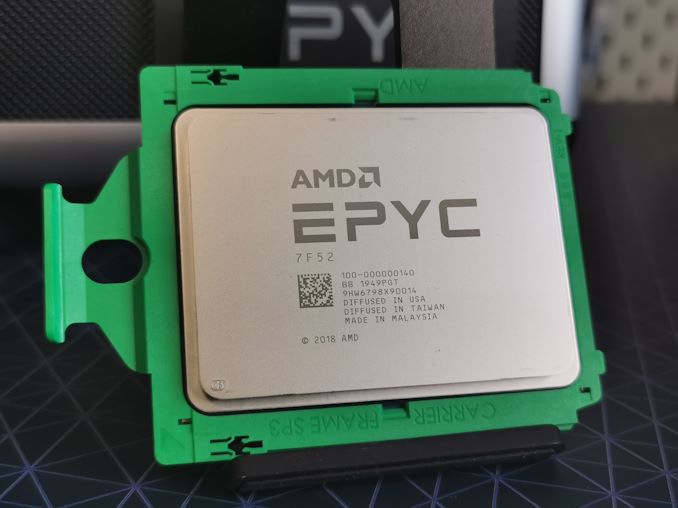AMD’s New EPYC 7F52 Reviewed: The F is for ᴴᴵᴳᴴ Frequency
by Dr. Ian Cutress on April 14, 2020 9:45 AM EST- Posted in
- CPUs
- AMD
- Enterprise
- Enterprise CPUs
- EPYC
- SP3r2
- CPU Frequency
- Rome
- 7Fx2
Conclusions
There are three main ways to increase modern computing performance: more cores, higher frequency, and a better instruction throughput per cycle (IPC).
The one everyone loves, but is the hardest to do, is to increase IPC – most modern processor designs, if they are evolutions of previous designs, try to ensure that IPC increases faster than power consumption, such that for every 1% increase in power, there might be 2% increase in IPC. This helps efficiency, and it helps everyone.
As we’ve seen with some recent consumer processors, IPC is nothing unless you can match the frequency of the previous generation. Increasing frequency should sound easy: just increase the voltage, which gives the unfortunate side effect of heat and decreases the efficiency. There’s also another element at play here, in physical design. The ability to produce a layout of a processor floorplan such that different parts of the CPU are not affecting the frequency is a key tenet to good physical design, and this can help boost maximum frequencies. If you can’t get IPC, then an increase in frequency also helps everyone.
An increase in core count is harder to quantify. More cores only helps users that have workloads that scale across multiple cores, or gives an opportunity for more users to work at once. There also has to be an interconnect to feed those cores, which scales out the power requirements. Cores doesn’t always help everyone, but it can be one of the easier ways to scale out certain types of performance.
With the new 7F range of Rome processors, AMD is hoping to stag that first second rung of the ladder. These new parts offer more frequency, but also improve the L3 cache to core ratio, which will certainly help a number of edge cases that are L3 limited or interconnect limited. There is a lot of demand for high frequency hardware, and given the success of the Naples 7371 processor from the previous generation, AMD has expanded its remit into three new 7F processors. The F is for Frequency.
The processor we tested today was the 7F52, the most expensive offering ($3100) which has 16 cores with a base frequency of 3.5 GHz and a turbo of 3.9 GHz. This is the highest turbo of any AMD EPYC processor, and this CPU is built such that there is 256 MB of L3 cache, offering the highest core-to-cache ratio of any x86 processor. At a full 16 MB per core, this means that there is less chance for congestion between threads at the L3 level, which is an important consideration for caching workloads that reuse data.
Our tests showed very good single thread performance, and a speedy ramp from idle to high power, suitable for bursty workloads where responsiveness matters. For high throughput performance, we saw some good numbers in our test suite, especially for rendering.
Personally, it’s great when we see companies like AMD expanding their product portfolio into these niche areas. High frequency parts, high cache parts, or custom designs are all par for the course in the enterprise market, depending on the size of the customer (for a custom SKU) or the size of the demand (to make the SKU public). AMD has been doing this for generations, and in the past even created modified Opterons for the Ferrari F1 team to do more computational fluid dynamics within a given maximum FLOPs. I’m hoping AMD lets us in on any of these special projects in the future.












97 Comments
View All Comments
bananaforscale - Wednesday, April 15, 2020 - link
Expecting EPYC F7U12.efferz - Wednesday, April 15, 2020 - link
the IPC of 9900KS is 1.56/G while the 6226R is 1.05/G?AntonErtl - Thursday, April 16, 2020 - link
Why buy an EPYC 7F52 rather than some other AMD CPU?Compared to a Ryzen 9 3950X? You need more than 128GB RAM, more than 4MB cache/core or more DRAM bandwidth; as for clock, they have the same base clock, and the 3950X has quite a bit more max clock.
Compared to a Threadripper 3960X (and not use, maybe deactivate 8 cores)? You need more then 256GB RAM, more than 8MB cache per core, or more RAM bandwidth; clockwise, the Threadripper is better in every way.
Compared to another Rome EPYC? You want 256MB cache, but want to pay less than for a 7642 or a 7702P; or you want a higher clock rate than other 16-core EPYCs offer.
This all seems quite specialized to me; I guess there are some supercomputing or database applications that benefit from high DRAM capacity and bandwidth and big caches; but if an application is DRAM-limited, it usually does not need high clocks (waiting for memory at a higher clock rate does not make the DRAM access significantly faster).
As for benchmarks, I guess Stream will show up the RAM bandwidth, but there it will perform like any other Rome EPYC.
scineram - Friday, April 17, 2020 - link
Ok, so how successful was the 7371?eastcoast_pete - Monday, April 20, 2020 - link
@Ian (Dr. Cutress): Again, appreciate your reviews! Question: Could you do a review of a Ryzen on the exact opposite end of the price scale, namely the Ryzen 3 1200? It is now Zen+, fabbed in GloFo's 12 nm LP process, and around or under $ 50. Not bad for 4 cores, especially if you have a dGPU and a compatible board at hand. Just make sure to update the BIOS as needed before installing the CPU.dwade123 - Tuesday, April 21, 2020 - link
Overpriced junk